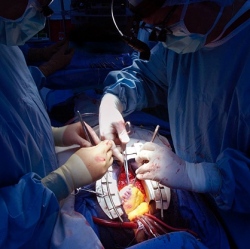
Combining cornstarch with volcanic ash clay to create a plastic for bone grafts could make the surgical process of bone replacement much simpler in the future. Researchers say the material could replace the need to remove bone from another part of a patient’s body, or to use donor cadaver bones that are limited in supply.
The preclinical findings come from researchers at Beaumont Hospital,Royal Oak and will be published in the journal Nanomedicine. They state that the biodegradable material could be used to heal bones in hundreds of thousands of patients requiring bone replacement, including following tumor removal, spinal fusion surgery or fractures.
Normally, bone grafts involve using bone from another part of the patient’s body, essentially adding a second surgical procedure and increased risk of complications to the process. Donor bones are also an option, but they may not always be available.
Kevin Baker, Ph.D., director of the Beaumont Orthopaedic Research Laboratories, worked on the study with Rangaramanujam Kannan, Ph.D., of Johns Hopkins (formerly with Wayne State University). He says the goal is to use the biodegradable graft material on its own, without having to add any permanent hardware like metal or plastic implants that are often used to support and strengthen traditional bone grafts.
"This improves outcomes for the patient because internal hardware can pose a challenge with respect to being a potential site for infection, and can complicate MRI and CT imaging tests," Baker says. "In addition, from the surgeon’s perspective, not having to worry about a large piece of metal or hard plastic in the area may make future procedures easier."
The biodegradable polymer is reinforced with montmorillonite clay nanoparticles (we’ve seen nanoparticles used in other ways to heal bones) for strength, and injected with carbon dioxide making the implant look like a kind of rigid foam that is porous like real bone. The researchers says it will dissolve in the body within 18 months as the new bone forms and heals.
The material is still in the earliest phases of research and development, meaning it will likely be several years before it is actually available to be used in patients.
